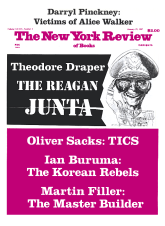In response to:
Art into Money from the July 17, 1986 issue
To the Editors:
Joseph Alsop is unquestionably the world’s leading expert on the art world as it existed in the past. His touch with more modern developments is, to put it mildly, less sure. In your issue of July 17th, 1986, he delivered a sweeping—and entirely unsupported—condemnation of all works (including my own book, Sold) “spawned by the current interest in art as merchandise.” “Inaccuracy and superficiality” seem to him their besetting sins.
There follows a paragraph of stupefying superficiality giving his reasons for the auctioneers’ post-war triumphs over the dealers. Confining himself to the narrow markets covered by the late Lord Duveen, he asserts that dealers were all-powerful until recent years because sellers were both ignorant and wary of publicity. In fact, since the modern art market was born (in the 1880s with the first sales of the hoards accumulated by the British aristocracy), the vendors have invariably cashed in on their names, realising that a piece from a named collection was worth more than one from an anonymous or unglamourous vendor. They also took very good care to root out the best advisors—i.e. the ones who came up with the highest valuation. Nor did Duveen buy cheaply. Part of his technique was to buy pictures at unheard-of prices. These looked low only after he had transformed them into what the late S.N. Behrman called “Genuine Duveens.”
Mr. Alsop’s assertion that the late Peter Wilson of Sotheby’s triumphed over the dealers because he alone could offer the vendors instant cash payments is also rather dubious. Even Duveen relied on bankers: and modern financiers seem quite willing to go into partnership with dealers to provide them with enough instant cash to compete with the auctioneers. If anything, Mr. Alsop’s reasoning has reinforced my conviction that the sheer force of personality of the late Peter Wilson had a lot to do with changing the course of art market history.
Nicholas Faith
Oxford, England
Joseph Alsop replies:
Nicholas Faith is entitled to his opinion—although it is exceedingly difficult to see how Lord Duveen, born very poor and notoriously extravagant, too, ended by making a large fortune unless he bought mighty cheap and sold mighty dear.
As to the sellers’ knowledge of values in the period under discussion, you have only to consider what is surely the greatest Italian picture in the United States. Titian’s Rape of Europa in the Gardner Collection was bought by Mrs. Jack Gardner for £20,000, or $100,000 in those days. One does not know what price was paid the seller, the Earl of Darnley, since the picture passed successively through the hands of the London firm of Colnaghi and of Bernard Berenson before reaching Mrs. Gardner.
It is a reasonable guess, however, that Lord Darnley’s present heirs always grind their teeth horribly whenever they think of the price paid for the Europa. And Mrs. Gardner, if she was buying any sort of name, paid her money for the Titian, without any thought of its provenance.
This Issue
January 29, 1987



